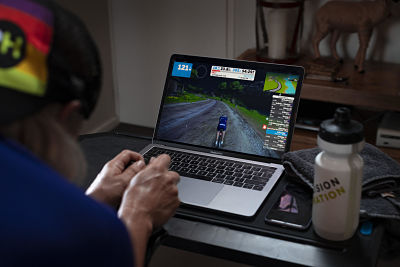With the cancellation and postponement of real racing, early 2021 felt like the right time to try out a virtual biking burn-up on Zwift.
For those contemplating their first race on Zwift, it feels fair to pass on the advice learned from the experience. I am now, writing this, a two-race "veteran". Well, three races if you count the one I crashed in...
So, as a relatively inexperienced Zwifter in general and less so as a racer, I’m going to pass on what I’ve learned so far.
Check everything is secure pre-race
So this might sound obvious, but check the bike is properly attached to your turbo. The skewer or thru-axle wants to be nice and secure before you start ragging your bike around like you’re Mark Cavendish on the final 500m of a Tour de France stage.
About 8-9 minutes into my first foray into the virtual racing world I felt the bike start to wobble. Nothing too concerning, I figured it was just the front wheel in the wrong place. Then all of a sudden the wobbling was a topple and I was going far further to the left than planned, heading into the floor.
Fortunately, the frame didn’t snap or the turbo snap in half, but by the time I was back up and the team mechanics (my wife and dogs who came charging in to see what all the noise was) helped me get back on the bike, the race had basically finished.
Have a start checklist
This matters more the longer your race is.
If you’re doing 15km in Crit City then you don’t need to worry too much about food and water, although a few swigs will help along the way.
If you have the "Four Horsemen of the Apocalypse" on a Saturday morning, then getting your snacks ready is key.
So have a little mental or physical checklist to go through. There’s nothing worse than starting off hard and then realising you’re not turned your fan on or left the big radiator next to your bike on full blast.
Little things like turning your fan on, having a microfibre towel handy, preparing snacks and PH 1500 drinks, and letting your other half or kids know that you might start grunting loudly towards the end so they’re not worried the Gruffalo has invaded the house.
Probably best to add “check bike is connected to turbo securely” on there too, but maybe that’s just me.

Do a nice warm-up
Like a normal race it’s good to have a wee warm-up beforehand, not least because the pace is electric from the gun, and this also gives you time to sort out any technical problems before the action starts too.
A wild example, say you fall off your bike the night before in your first ever Zwift race, then it’s worthwhile having a decent warm up to check everything is working properly. If you start 5 minutes before the race and then notice you’ve managed to kink a link in your chain, you’re missing the start.
Add in some short race effort level sprints (we’d call them 'stride outs' in running) to get the legs and muscles prepared for what’s ahead, especially given point four.
Start like you mean it
About 5-10 seconds before the race starts, get well above your FTP. The first few hundred metres is a battle to be in the front group and get the benefit of the draft. If you don’t start at suicide pace, then you’ll be left behind.
It only takes a short effort to get that initial jump, but unfortunately that’s not where the effort ends. For at least a few minutes, but maybe a bit longer, everyone is working well above the level you’d expect.
Hanging on at this stage is key because the drafting really makes a difference, and trying to catch up on a group containing Alistair and Jonny Brownlee up the Volcano Climb is going to require super human efforts, which becomes impossible going solo on the downhill.
So keep at it and eventually it calms down a little (or just continues on to the finish) and you can be a bit more tactical, sitting in behind for those aero gains.
Learn the course
Last, but not least, have a look at the course beforehand. Where are the bigger climbs? Is there a long descent to recover on and can you use the super tuck? (At -4% and 50kph you can stop pedalling and your avatar still bombs it downhill in a tucked aero position whilst you recover).
Look at the points where people might push away and start thinking about your finish line push. Is it a looped course? As that might mean you can get away with recceing it on the first eight loops and not worry too much, but even a sudden steep ramp on loop one could see you out the back of the group and working extra hard to get back.
Think about your strengths, but also what you’re trying to get out of the session. Unless you’re a pro-e-racer (is that a thing?), this is part of your training.
So finding a course with 3 x 10 minute hills could be a great replacement for that FTP session you had and a bit more fun. A flat 20-minute race? Well that’s a totally different session but could be equally as valuable.
I know my weaknesses (some of them) on the bike and it’s the flat, sustained efforts. That means you’ll find me doing a few faster, flatter events, but maybe chucking in some hilly ones for a bit of confidence too.
At least my shoddy downhill skills don’t let me down in a virtual race.
